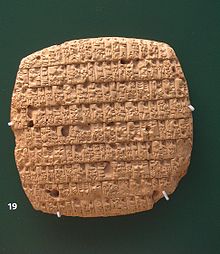Gaston Cros
Upon the outbreak of the First World War Cros was recalled to metropolitan France and fought in defence of Paris at the First Battle of the Marne, leading an ad hoc unit of zouaves and tirailleurs.
[1][2] After Alsace was incorporated into the German Empire after the Franco-Prussian War of 1871 Cros' family chose to retain their French nationality and moved to Lunéville in Meurthe-et-Moselle.
He replaced the late Ernest de Sarzec, the French consul of Basra, who died in 1901 and had been excavating Tello since 1877, having initiated the rediscovery of the Sumerian civilization.
[2][8] The appointment of a military man to this position might have been influenced by the revolt of the Muntafiq Arabs against the Ottoman Empire which created a hostile environment for the archaeologists.
[9] Cros' knowledge of archaeology, like Sarzac's, came from a purely amateur interest in the subject though he had a thorough understanding of desert topography from his surveying days.
[5] Cros undertook numerous excavations at Tello producing significant numbers of artefacts, some dating from the earliest periods of Sumerian civilization.
[3] His archaeological work was recognised by promotion to chef de bataillon (roughly equivalent to major), in the 116th Infantry Regiment, on 24 June 1905 and by appointment as an officer of the Legion of Honour on 12 March 1906.
[3] He left Tello after his posting to the 5th Regiment but returned in 1909 to conclude his research, for which he was commended by Gaston Doumergue, the Minister of Fine Arts.
[17][18] After the outbreak of the First World War Cros returned to France from Africa, with the 8th Marching Regiment (an ad hoc unit made up of tirailleurs and zouaves).
[2][23] He also received a further mention in dispatches as "a brave soldier, an experienced great leader, wise, prudent, with natural authority" and was awarded the Croix de Guerre with palm.
[20] Later that year Cros led his brigade, as part of the 1st Moroccan Infantry Division, at the Second Battle of Artois - an allied attempt to capture Vimy Ridge with an assault on a 13-mile-wide (21 km) stretch of the front.
[24] The five-hour preliminary bombardment was largely ineffective, and the division took heavy casualties in reaching the German lines, 3 miles (4.8 km) distant.
On 9 May 1915, the regiments of the Moroccan Division at 10AM launched their offensive from the Berthonval trenches and successfully overcame fierce resistance from the German side to claim victory over Hill 140, their objective - breaking through enemy lines for the very first time



